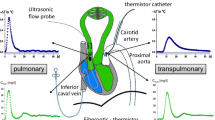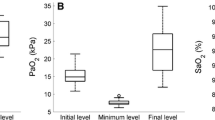Abstract
Objective: Pulmonary flow resistance is mainly determined by vessel calibres, resulting from the interaction of volume-passive distension and active vasomotion. However, quantitative information on the interplay between these counteracting forces in the lung is lacking. Therefore, we aimed at quantifying (1) the effects of vasomotor tone on pulmonary blood volume (Qp) and (2) the influence of Qp on vascular reactivity. Design: Experimental study in isolated zone III rabbit lungs perfused with autologous blood. Setting: Research department of experimental anaesthesiology. Interventions: Stepwise changes of pulmonary blood flow (Q˙= 0 – 200 ml · min–1) and Qp (10–30 ml) were applied independently of each other during normoxia (control), hypoxic vasoconstriction (3 % O2) and vasodilation by papaverine (10–4 M). Measurements: The arteriovenous pressure gradient (ΔP) was calculated as the difference between the pressures in the pulmonary artery and the left atrium. Qp was continuously measured as reciprocal volume changes in the blood reservoir. Results: Vasomotor interventions did not alter Qp despite substantial changes in pulmonary artery pressure. Vasoconstriction and decreasing Qp shifted the pressure/flow curves to greater ΔP, whereas vasodilation, as well as increasing Qp, had the opposite effect. Analysis of the pressure/flow relations by the equation ΔP = K · Q˙m revealed that both parameters (K and m) were functions of Qp but only K was affected by vasoconstriction and vasodilation. K, an indicator of flow resistance, decreased hyperbolically to one-sixth and approached each other as Qp was tripled, whereas m increased only 1.5-fold (0.5–0.8). The factorial changes of K from constricted to dilated states varied from 2 to 2.9 and attained a maximum at Qp = 20 ml. Conclusions: Pulmonary blood volume, although not affected by vasomotor interventions, attenuates vascular reactivity in the lung.
Similar content being viewed by others
Author information
Authors and Affiliations
Additional information
Received: 28 March 1999 Accepted: 1 October 1999
Rights and permissions
About this article
Cite this article
Ding, Z., Scheeren, T. & Arndt, J. Effects of pulmonary blood volume on vascular reactivity in the lung. Intensive Care Med 25, 1413–1420 (1999). https://doi.org/10.1007/s001340051090
Published:
Issue Date:
DOI: https://doi.org/10.1007/s001340051090




